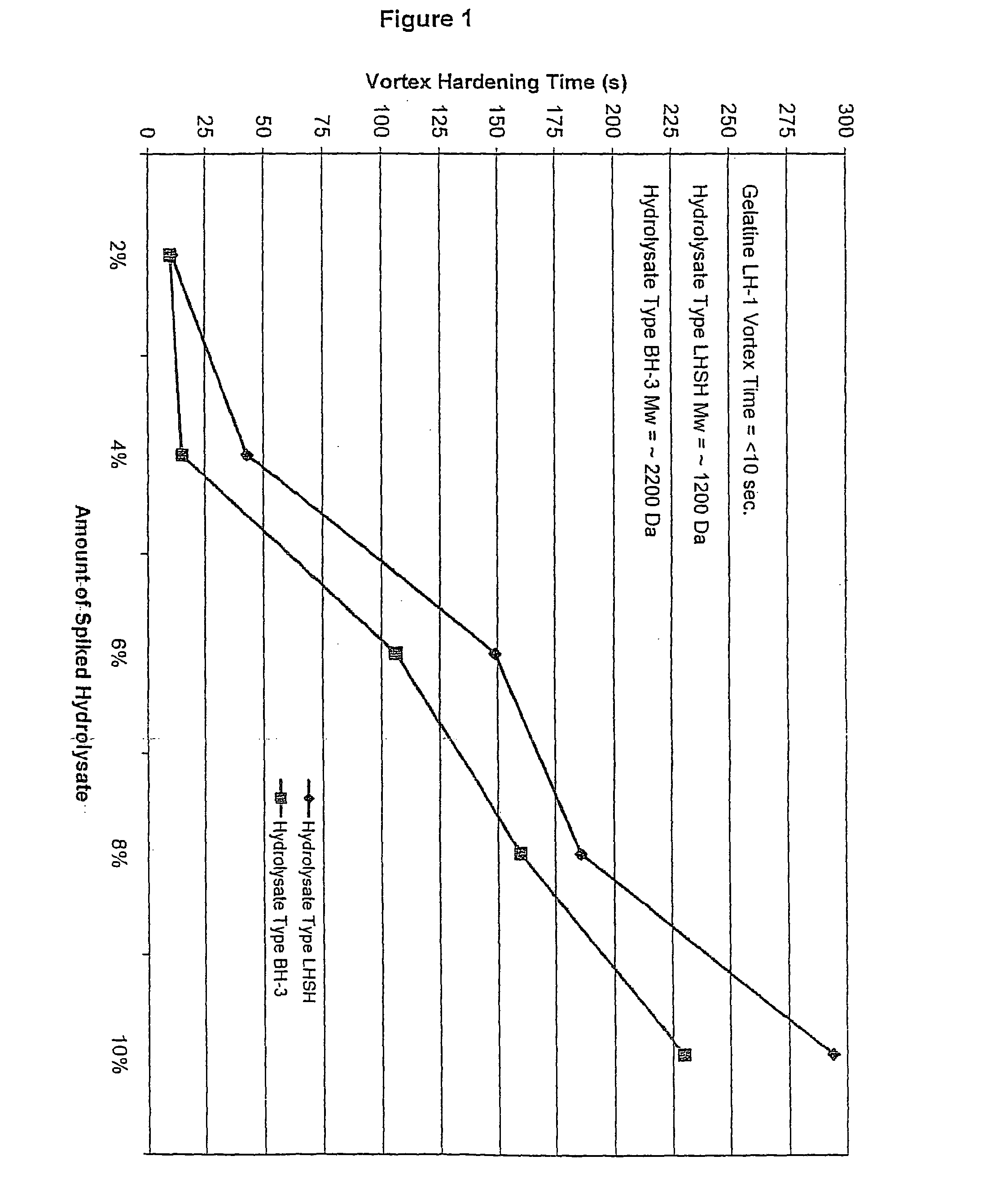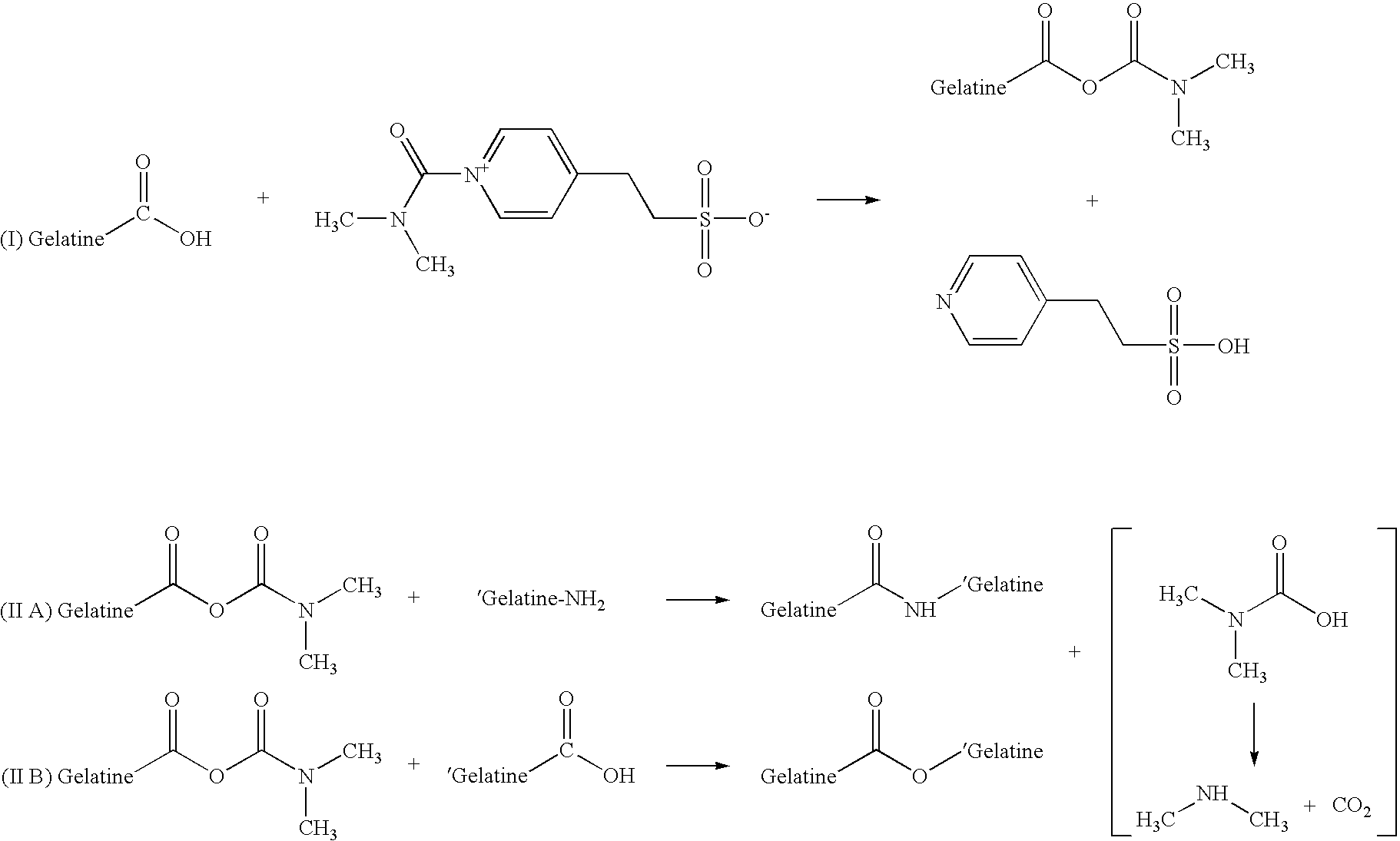Process for Making a Low Molecular Weight Gelatine Hydrolysate and Gelatine Hydrolysate Compositions
a gelatine hydrolysate and low molecular weight technology, applied in the field of gelatine hydrolysate gelatine hydrolysate composition, etc., can solve the problems of affecting the performance of gelatine capsules, etc., to achieve the effect of reducing cross-linking in gelatine, reducing cross-linking
- Summary
- Abstract
- Description
- Claims
- Application Information
AI Technical Summary
Benefits of technology
Problems solved by technology
Method used
Image
Examples
example 1
[0092]The gelatine hydrolysate of the invention may be made according to the following process. A solution containing 34% by weight gelatine (limed-bone gelatine Type B, Bloom=100) was made by adding 1.94 kg of water to 1.0 kg of de-ionized processed gelatine. The gelatine was left to hydrate for 1 hour and then placed into a 55° C. water bath to dissolve. Once completely dissolved, the pH of the gelatine solution was adjusted to 6.0-6.5 with aqueous sodium hydroxide. Calcium Chloride was added to the gelatine solution in the amount of 0.0370% w / w with the amount of gelatine in solution (CDG—Commercial Dry Gelatine (having a moisture content of about 10% by weight), all additions in this procedure were based on this amount). An aliquot was taken and was diluted to 5% by weight in order to test the Redox State of the solution. Peroxide testing strips (EM Science) were used to quickly measure the amount of peroxide. If peroxide was present, Fermcolase® 1000F (Genencor International In...
example 2
[0094]The following procedure was used to quantify the degree of reduction in cross-linking for various gelatine compositions. In the control experiments, 10.0±0.1 g of a gelatine was added to a 250 ml beaker, to which was added 90.0±0.5 g of de-ionized water. A watch glass was placed on the beaker and the gelatine was allowed to swell for 30-60 minutes. The swelled gelatine was placed into a 60±0.1° C. water bath for 15-30 minutes or until all of the gelatine was dissolved. A magnetic stir bar was placed into the gelatine solution and the pH was adjusted upon a stir plate with dilute NaOH or H2SO4 to a pH of 7.00±0.05 after which the magnetic stir bar was removed. The solution was placed into a water 40±0.1° C. water bath for 15-60 minutes to cool. A digital stirring motor (Heidolph Brinkman 2102) equipped with a 4-blade mixer was used to create vortex at 750±10 RPM. Immediately, 20±0.5 ml of a pH 7 phosphate buffered 10% formalin solution (Fisher Scientific) was added. The vortex ...
example 3
[0101]The gelatine hardening agent OB1207® [2-(4-Dimethylcarbamoyl-pyridino)-ethane-1-sulfonate] was acquired from H.W. Sands Corporation. OB1207® has been touted as a replacement for formaldehyde in photographic emulsions. Reaction 1 describes the cross-linking of OB1207® with gelatine. The formation of amide and ester bonds between gelatine chains through the reaction with OB1207® may closely mimic the type of cross-linking seen in gelatine samples that have been aged and / or stressed due to exposure to extremes of heat and humidity.
Reaction 1
[0102]In control experiments, 15.0±0.1 g of gelatine (limed-bone gelatine Type B, Bloom=200) was added into a 250 ml flask. To this, 95.0±0.5 g of de-ionized water and a magnetic stir bar was added. The gelatine was covered with parafilm allowed to swell for 30-60 minutes. The flask was placed into a 60±1.0° C. water bath for 15-20 minutes or until all of the gelatine was dissolved. The viscosity of this solution was measured using a Brookfiel...
PUM
| Property | Measurement | Unit |
|---|---|---|
| average molecular weight | aaaaa | aaaaa |
| temperature | aaaaa | aaaaa |
| molecular weight | aaaaa | aaaaa |
Abstract
Description
Claims
Application Information
 Login to View More
Login to View More - R&D
- Intellectual Property
- Life Sciences
- Materials
- Tech Scout
- Unparalleled Data Quality
- Higher Quality Content
- 60% Fewer Hallucinations
Browse by: Latest US Patents, China's latest patents, Technical Efficacy Thesaurus, Application Domain, Technology Topic, Popular Technical Reports.
© 2025 PatSnap. All rights reserved.Legal|Privacy policy|Modern Slavery Act Transparency Statement|Sitemap|About US| Contact US: help@patsnap.com



